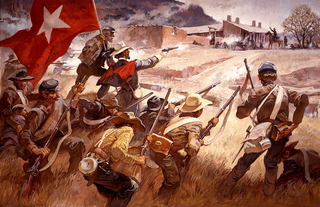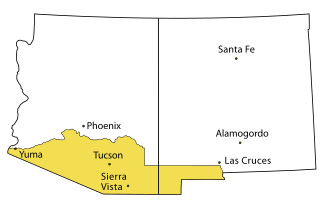
The Territory of Arizona, commonly known as the Arizona Territory, was a territory of the United States that existed from February 24, 1863, until February 14, 1912, when the remaining extent of the territory was admitted to the Union as the state of Arizona. It was created from the western half of the New Mexico Territory during the American Civil War.

Arizona Territory, colloquially referred to as Confederate Arizona, was an organized incorporated territory of the Confederate States of America that existed from August 1, 1861, to May 26, 1865, when the Confederate States Army Trans-Mississippi Department, commanded by General Edmund Kirby Smith, surrendered at Shreveport, Louisiana. However, after the Battle of Glorieta Pass, the Confederates had to retreat from the territory, and by July 1862, effective Confederate control of the territory had ended. Delegates to the secession convention had voted in March 1861 to secede from the New Mexico Territory and the Union, and seek to join the Confederacy. It consisted of the portion of the New Mexico Territory south of the 34th parallel, including parts of the modern states of New Mexico and Arizona. The capital was Mesilla, along the southern border. The breakaway region overlapped Arizona Territory, established by the Union government in February 1863.

The New Mexico campaign was a military operation of the trans-Mississippi theater of the American Civil War from February to April 1862 in which Confederate Brigadier General Henry Hopkins Sibley invaded the northern New Mexico Territory in an attempt to gain control of the Southwest, including the gold fields of Colorado and the ports of California. Historians regard this campaign as the most ambitious Confederate attempt to establish control of the American West and to open an additional theater in the war. It was an important campaign in the war's Trans-Mississippi Theater, and one of the major events in the history of the New Mexico Territory in the American Civil War.

The Battle of Picacho Pass, also known as the Battle of Picacho Peak, was an engagement of the American Civil War on April 15, 1862. The action occurred around Picacho Peak, 50 miles (80 km) northwest of Tucson, Arizona. It was fought between a Union cavalry patrol from California and a party of Confederate pickets from Tucson, and marks the westernmost battle of the American Civil War involving fatalities.

John Robert Baylor was a US Indian agent, publisher and editor, politician, and a senior officer of the Confederate States Army. After being dismissed as Indian agent, he became one of the founding editors of The White Man, a newspaper in North Texas, and a strong critic of Governor Sam Houston.

Dr. Lewis S. Owings was an American politician, physician, and businessman from Tennessee who served as the 2nd Governor of Arizona Territory (Confederate), in exile, from 1862 to 1865. He had previously served as provisional governor of Arizona Territory from 1860 to 1861.

The First Battle of Mesilla was fought on July 25, 1861, at Mesilla in New Mexico Territory, in present-day Doña Ana County, New Mexico.

California's involvement in the American Civil War included sending gold east to support the war effort, recruiting volunteer combat units to replace regular U.S. Army units sent east, in the area west of the Rocky Mountains, maintaining and building numerous camps and fortifications, suppressing secessionist activity and securing the New Mexico Territory against the Confederacy. The State of California did not send its units east, but many citizens traveled east and joined the Union Army there, some of whom became famous.

The Colorado Territory was formally created in 1861 shortly before the bombardment of Fort Sumter sparked the American Civil War. Although sentiments were somewhat divided in the early days of the war, Colorado was only marginally a pro-Union territory. Colorado was strategically important to both the Union and Confederacy because of the gold and silver mines there as both sides wanted to use the mineral wealth to help finance the war. The New Mexico Campaign was a military operation conducted by Confederate Brigadier General Henry Sibley to gain control of the Southwest, including the gold fields of Colorado, the mineral-rich territory of Nevada and the ports of California. The campaign was intended as a prelude to an invasion of the Colorado Territory and an attempt to cut the supply lines between California and the rest of the Union. However, the Confederates were defeated at the Battle of Glorieta Pass in New Mexico and were forced to retreat back to Texas, effectively ending the New Mexico Campaign.

The New Mexico Territory, comprising what are today the U.S. states of New Mexico and Arizona, as well as the southern portion of Nevada, played a small but significant role in the trans-Mississippi theater of the American Civil War. Despite its remoteness from the major battlefields of the east, and its being part of the sparsely populated and largely undeveloped American frontier, both Confederate and Union governments claimed ownership over the territory, and several important battles and military operations took place in the region. Roughly 7,000-8,000 troops from the New Mexico Territory served the Union, more than any other western state or territory.
Marcus H. MacWillie was a politician who represented the Confederate Arizona Territory in the Congress of the Confederate States during the American Civil War.

The First Battle of Dragoon Springs was a minor skirmish between a small troop of Confederate dragoons of Governor John R. Baylor's Arizona Rangers, and a band of Apache warriors during the American Civil War. It was fought on May 5, 1862, near the present-day town of Benson, Arizona, in Confederate Arizona.

Prior to the adoption of its name for a U.S. state, Arizona was traditionally defined as the region south of the Gila River to the present-day Mexican border, and between the Colorado River and the Rio Grande. It encompasses present-day Southern Arizona and the New Mexico Bootheel plus adjacent parts of Southwestern New Mexico. This area was transferred from Mexico to the United States in the Gadsden Purchase of 1853. Mining and ranching were the primary occupations of traditional Arizona's inhabitants, though growing citrus fruits had long been occurring in Tucson.
The Battle of Pinos Altos was a military action of the Apache Wars. It was fought on September 27, 1861, between settlers of Pinos Altos mining town, the Confederate Arizona Guards, and Apache warriors. The town is located about seven miles north of the present day Silver City, New Mexico.
The San Elizario Spy Company or Coopwood Spy Company was an independent volunteer company of cavalry formed by Captain Bethel Coopwood and mustered into Confederate service on July 11, 1861 in El Paso, Texas.
The Company A, Arizona Rangers was a cavalry formation of the Confederate States Army during the American Civil War.
The Department of New Mexico was a department of the United States Army during the mid-19th century. It was created as the 9th Department, a geographical department, in 1848 following the successful conclusion of the Mexican–American War, and renamed Department of New Mexico in 1853. It had to contend with an invading Confederate force during the New Mexico Campaign of the American Civil War from mid-1861 to early 1862, then with Apache tribes during the remainder of the conflict. It was merged into the Department of California after the end of the war as the District of New Mexico.

Union forces entered Tucson on May 20, 1862, with a force of 2,000 men without firing a shot.
Sherod Hunter was the commander of the Confederate unit operating against Union Army forces in present-day Arizona during the American Civil War. He later commanded various Confederate cavalry units elsewhere in the Trans-Mississippi Theater.

The 1st Texas Cavalry Regiment (Arizona Brigade) was a unit of mounted volunteers from Texas that fought in the Confederate States Army during the American Civil War. In fall 1861, John R. Baylor first conceived the idea to form a brigade of cavalry to conquer the southwestern territories for the Confederacy. Baylor recruited a four-company battalion of cavalry which was placed under the command of Philemon T. Herbert. In May 1862, the Confederate States Army empowered Baylor to organize five battalions of Partisan Rangers of six companies each. Since its aim was to recapture the territories lost during the New Mexico campaign, it was called the name Arizona Brigade. Henry Hopkins Sibley dismissed Baylor and appointed Peter Hardeman as the battalion's commander. It camped at Victoria, Texas, from summer 1862 to April 1863, part of the time under the temporary leadership of William Polk Hardeman. The unit, now a full regiment, joined Richard Montgomery Gano's cavalry brigade in the Indian Territory. In 1864, it fought at Poison Spring and Cabin Creek. Subsequently, the regiment was ordered to march to Hempstead, Texas, where it was dismounted. Later its numbers dwindled to 175 men. On May 15, 1865, the unit disbanded while camped near Richmond, Texas.













